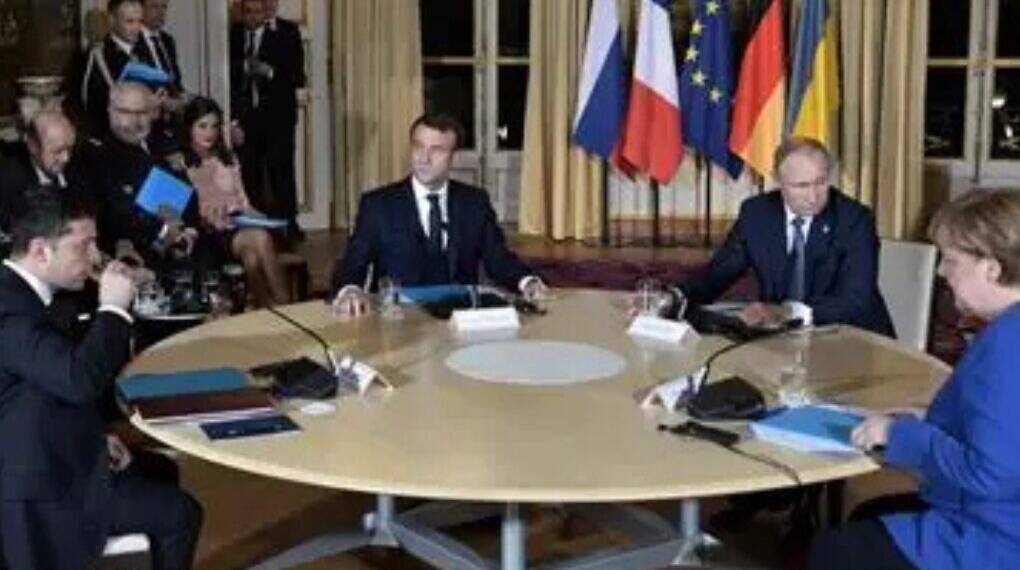In the long and bitter history of the Russia–Ukraine conflict, one detail often surprises many: Russian President Vladimir Putin and Ukrainian President Volodymyr Zelensky have only ever met in person once. That meeting took place on December 9, 2019, at the Normandy Format summit in Paris, where the leaders of France and Germany mediated discussions aimed at ending the war in eastern Ukraine.
The Paris Summit of 2019
Zelensky, still in the early months of his presidency, entered the summit with a strong electoral mandate to bring peace. He was relatively new to politics, having transitioned from entertainment into the highest office in Ukraine just months earlier. Putin, by contrast, was a veteran statesman with decades of experience, approaching the talks with the confidence of someone who had carefully shaped Russia’s position in the region.
The Paris meeting was focused on practical steps to reduce fighting in the Donbas region, where Russian-backed separatists controlled territory. The summit produced a commitment to prisoner exchanges, limited troop withdrawals from frontline positions, and a fragile pledge to maintain a ceasefire.
But beyond these incremental steps, the core disputes remained unresolved. Russia insisted that the Donbas be granted autonomy before Ukraine regained full border control, while Ukraine demanded sovereignty and territorial integrity as non-negotiable.
Though modest in outcome, the Paris summit carried immense symbolic weight. It marked the only time Putin and Zelensky came face-to-face, testing each other’s resolve and leadership in a highly scrutinized environment.
A Frozen Format
After 2019, the Normandy Format lost momentum. Ceasefires quickly unraveled, and attempts to revive negotiations stalled. The diplomatic track effectively froze, while tensions escalated. By early 2022, Russia launched a full-scale invasion of Ukraine, shattering the limited progress achieved in Paris.
Since then, Putin and Zelensky have not met again in person. Their only exchanges have been through press statements, intermediaries, and international forums. The absence of direct dialogue between the two leaders has underscored how far the war has moved beyond the framework of earlier peace processes.
The Prospect of a Trilateral Meeting
Now, in 2025, the diplomatic landscape has shifted once more. Following recent talks between Putin and U.S. President Donald Trump, attention has turned to the possibility of a trilateral summit involving Putin, Zelensky, and Trump. If realized, this would mark not only the first time Putin and Zelensky sit across from one another since 2019, but also the first occasion in which a U.S. president directly joins them at the same table.
The trilateral format is being discussed in Washington, with Trump signaling his willingness to mediate and push for a comprehensive peace deal rather than temporary ceasefires. For Zelensky, participation in such talks could offer a path to secure stronger international guarantees for Ukraine’s sovereignty. For Putin, it represents a chance to present Russia’s demands for territorial concessions and security arrangements in the eyes of a global audience.
The Stakes
The stakes for such a meeting are immense. If convened, it would likely revolve around three contentious issues: Ukraine’s territorial integrity, the status of Crimea and Donbas, and the country’s relationship with NATO. Zelensky has consistently held that Ukraine cannot cede territory, while Putin has made recognition of Russian control a precondition for peace. Trump, meanwhile, has suggested that compromises must be found quickly, portraying himself as a broker who can end the war.
This creates a delicate balance. For Ukraine, any concessions risk undermining national sovereignty and public trust. For Russia, the failure to secure concessions would be seen as a diplomatic defeat after years of war. For the United States, success would reinforce its role as a decisive power in global conflict resolution, while failure could weaken credibility.
The Paris summit of 2019 remains the only direct meeting between Putin and Zelensky to date, a moment of cautious optimism that ultimately gave way to years of intensified conflict.
The possibility of a new trilateral summit involving Putin, Zelensky, and Trump represents the next chapter in this high-stakes diplomatic struggle. Whether it results in genuine progress or becomes another symbolic handshake will depend on the willingness of all parties to bridge seemingly irreconcilable positions.
If it takes place, it could be remembered as either the long-awaited breakthrough—or as another reminder of how elusive peace in Ukraine has proven to be.








